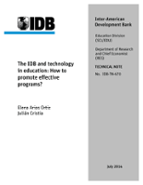The IDB and Technology in Education: How to Promote Effective Programs?
Date
Jul 2014
Today, there is a general consensus about the fact that a high level of learning is important for economic growth. However, students in Latin America and the Caribbean have lower scores on standardized learning tests compared to other countries at similar stages of economic development, and much lower than that of the best performing countries. So how does the use of technology in education can help increase student learning? New technologies open opportunities to increase student learning and have the potential to reduce gaps between socioeconomic groups. Governments in the region, aware of the opportunities and challenges of technology, have made significant investments in increasing student access to computers and the internet mainly through delivery models like one to one. Between 2006 and 2012, 20 of the 26 IDB member borrowers have promoted such initiatives and have distributed nearly 10 million laptops in public schools throughout the region. However, evidence suggests that infrastructure and technology are necessary but not sufficient conditions and should be geared specifically towards improving learning. The key question is: how can we design and implement effective technology to improve children learning? The objective of this technical note is to describe the principles that will guide the operational and analytical work of the Inter-American Development Bank (IDB) in the area of technology in education to promote effective programs that will enhance the skills of students in Latin America and the Caribbean.



